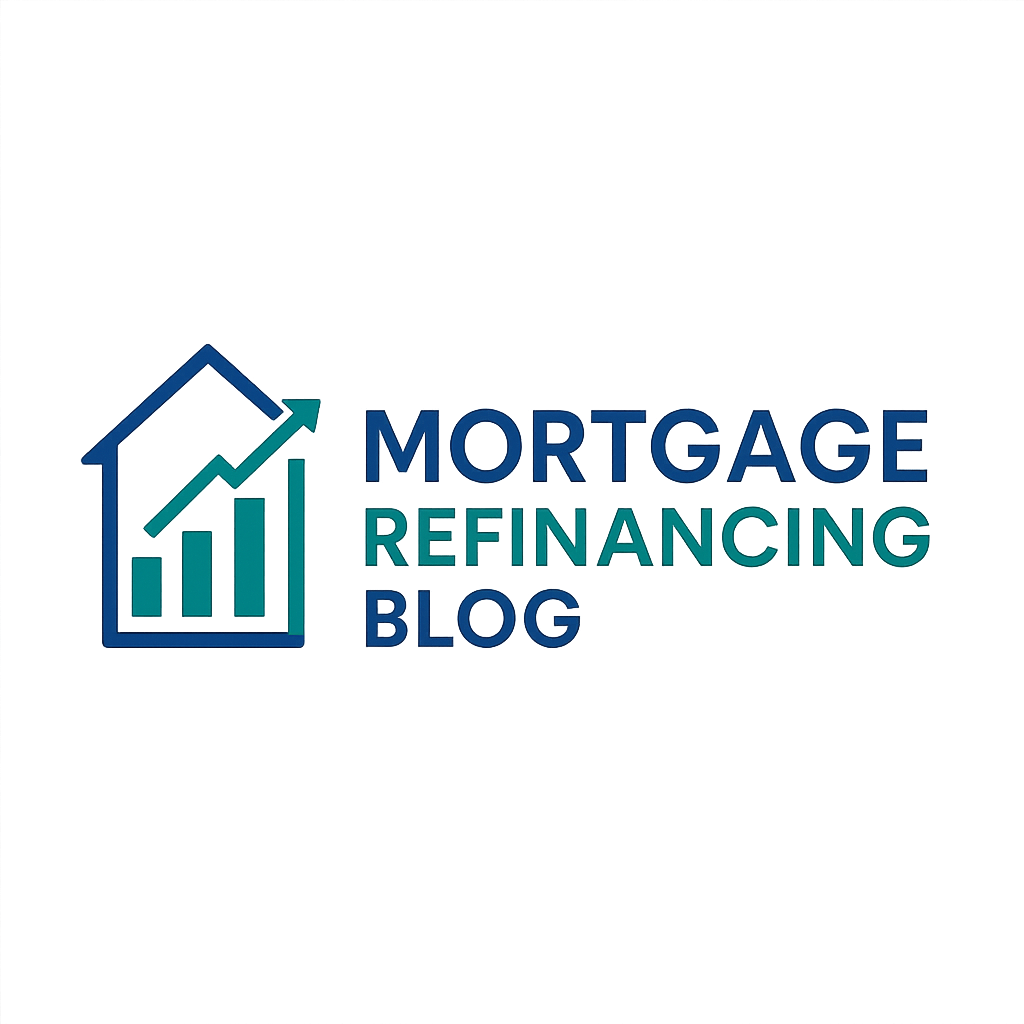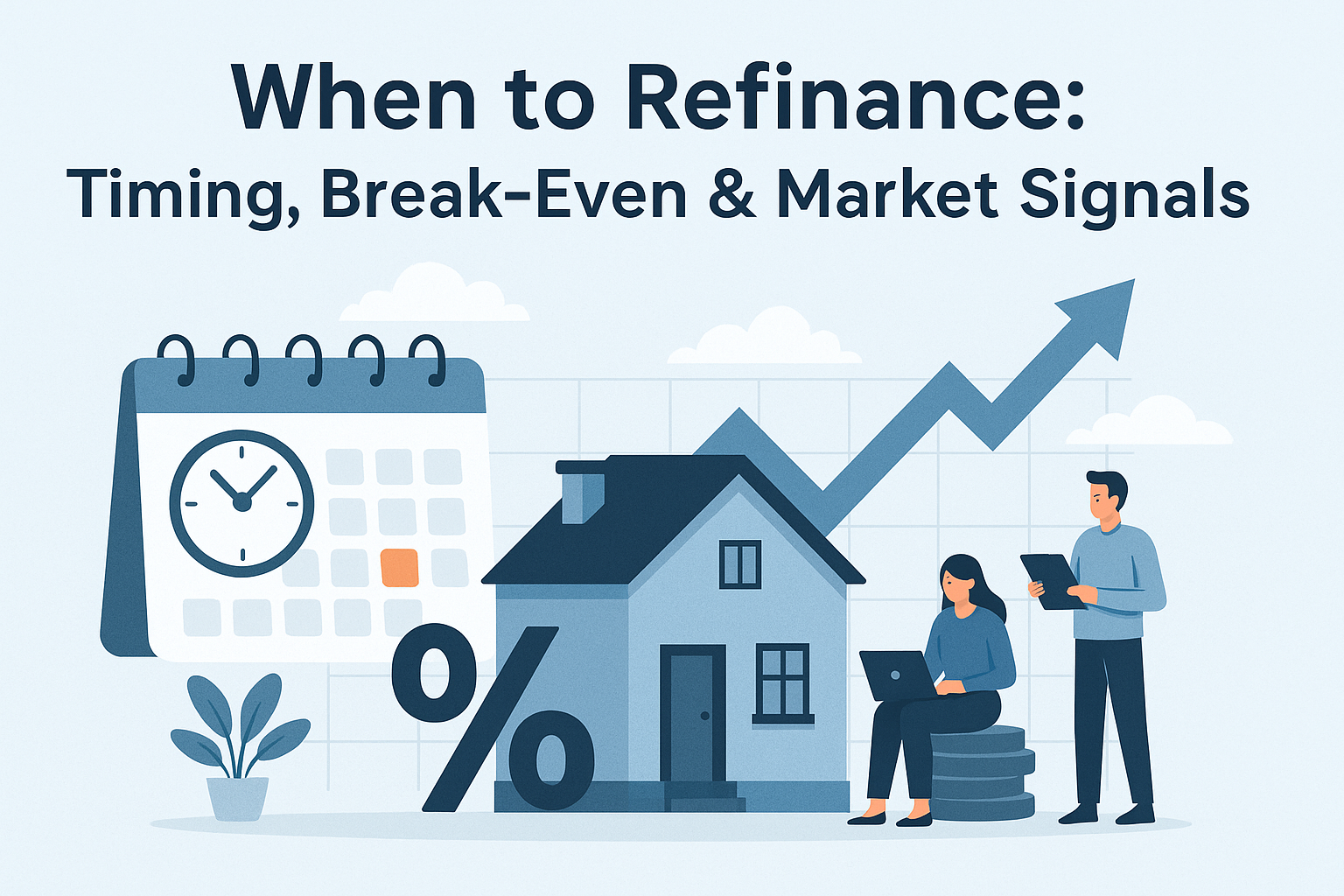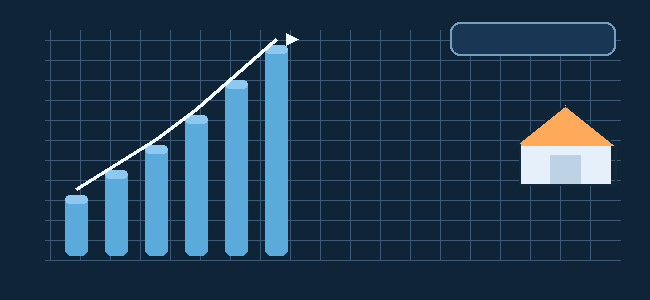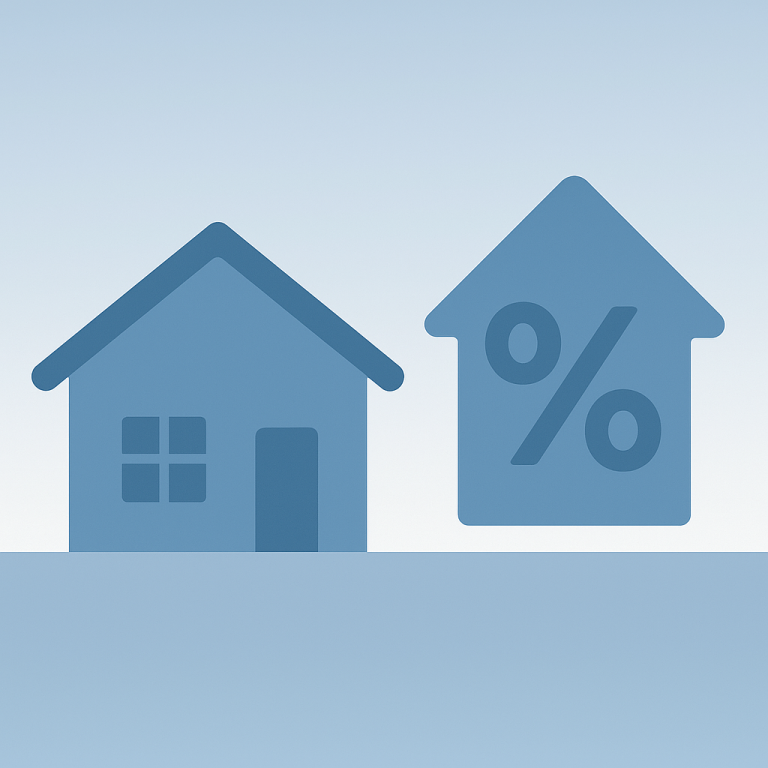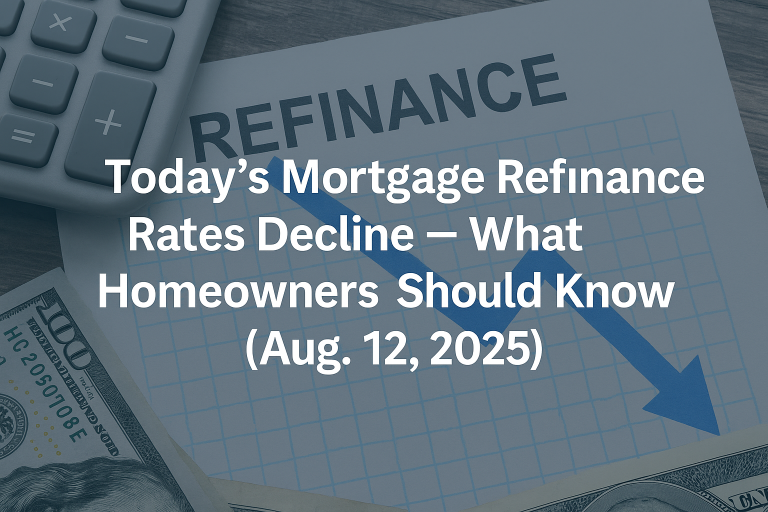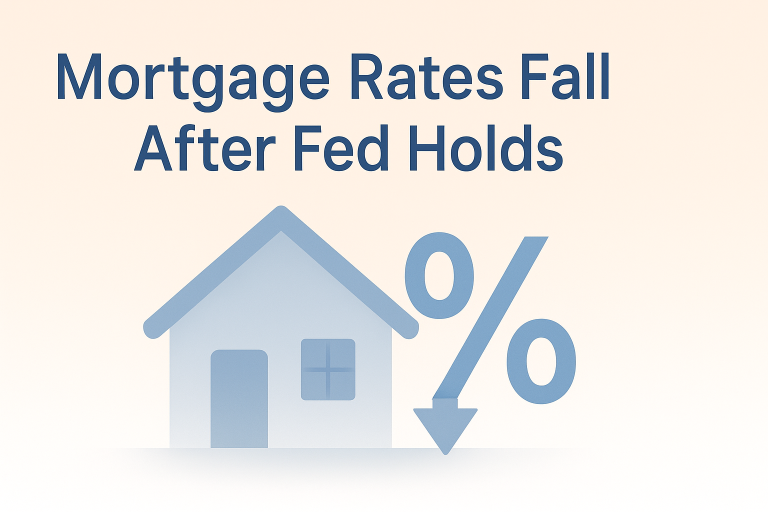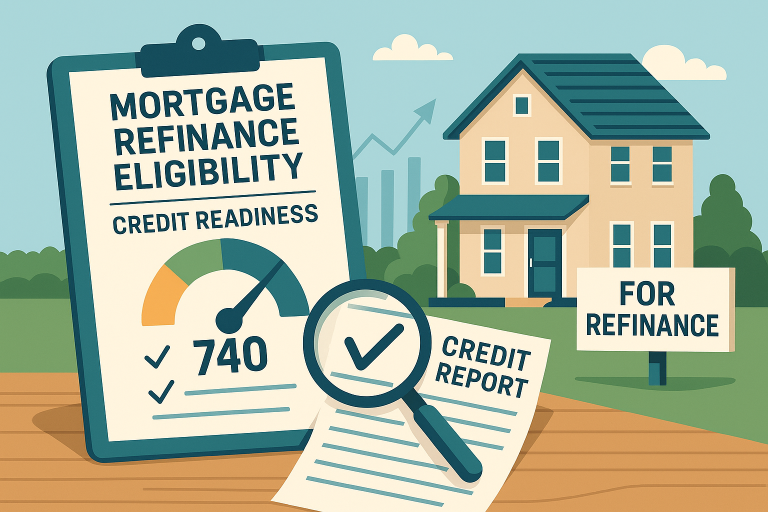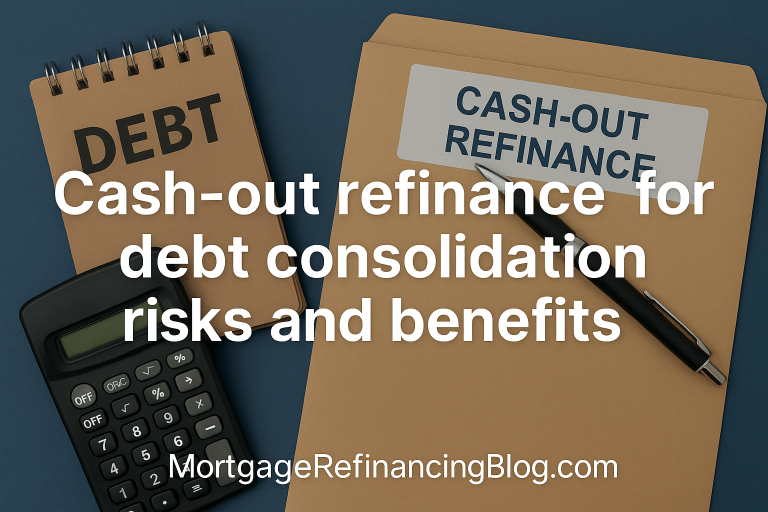When to Refinance: Timing, Break-Even & Market Signals
Rate Volatility Makes Timing Critical
Mortgage rate volatility has reached unprecedented levels in 2025, with daily fluctuations of 0.02% to 0.06% becoming the norm rather than the exception. Recent data shows rates moving from 6.77% on July 9th to 6.85% by July 15th—a 0.08% swing in just six days[1]. This volatility stems from conflicting economic signals: stronger employment reports pushing rates higher while recession fears pull them lower. The Federal Reserve’s cautious approach to rate cuts, maintaining the federal funds rate at 4.25-4.5% since December 2024, adds another layer of uncertainty[2]. For homeowners, this creates both opportunity and risk—the right timing could save thousands, while poor timing could lock in unfavorable rates for decades. Understanding market signals, calculating break-even points, and recognizing personal financial milestones has never been more crucial for successful refinancing decisions.
Why Timing Matters More Than Ever
Market Conditions Drive Opportunity Windows
The mortgage market operates in cycles, and 2025 presents unique timing challenges. Unlike the predictable rate environment of previous decades, today’s market responds rapidly to economic data releases, geopolitical events, and Federal Reserve communications. A single inflation report can move rates 0.25% in a day, dramatically altering refinancing economics.
Current market conditions show rates declining for five consecutive weeks before reversing higher after a strong jobs report[3]. This pattern illustrates why timing matters: homeowners who acted during the decline saved significantly compared to those who waited.
Personal Financial Timing Factors
Beyond market conditions, personal financial timing plays a crucial role. Life events such as credit score improvements, equity accumulation, or income changes can dramatically affect refinancing opportunities. The intersection of favorable market conditions and optimal personal circumstances creates the ideal refinancing window.
Cost of Delay
With closing costs averaging 2-5% of loan amounts, delayed decisions can be expensive. On a $300,000 mortgage, a 0.25% rate increase costs approximately $40 monthly or $14,400 over 30 years. This highlights why understanding timing signals is essential for maximizing refinancing benefits.
Calculating the Break-Even Point
The Basic Formula
The break-even point represents the time required to recoup refinancing costs through monthly savings. The calculation is straightforward:
Break-Even Point = Total Closing Costs ÷ Monthly Payment Reduction
However, this simple formula doesn’t account for the time value of money, opportunity costs, or tax implications. A more comprehensive analysis considers these factors for accurate decision-making.
Break-Even Analysis Example
| Current Loan Amount | $350,000 |
|---|---|
| Current Rate | 7.25% |
| New Rate | 6.75% |
| Monthly Savings | $177 |
| Closing Costs | $8,500 |
| Break-Even Period | 48 months |
Advanced Break-Even Considerations
Simple break-even calculations miss important factors:
Opportunity Cost: Money spent on closing costs could be invested elsewhere. If you can earn 7% annually on investments, the true break-even period extends beyond the basic calculation.
Tax Implications: Mortgage interest deductions affect net savings. Higher-income borrowers in elevated tax brackets may see greater benefits from refinancing.
Prepayment Scenarios: If you plan to pay extra principal, the break-even period shortens as total interest savings increase.
Home Sale Timeline: If you plan to sell before reaching break-even, refinancing may not be beneficial unless you can transfer the loan to another property.
Reading Rate Trends: Current Market Signals
Latest Rate Movements
Understanding current rate trends provides crucial timing insights. Recent data reveals:
July 15, 2025: 30-year fixed rates at 6.85%, up 0.02% from previous day[4] July 14, 2025: 30-year fixed rates at 6.83%, showing slight upward momentum[5] July 11, 2025: 30-year fixed rates at 6.82%, ending five weeks of declines[6]
This pattern suggests rates may be establishing a floor around 6.8%, with upward pressure from stronger economic data. The key question for refinancing timing is whether this represents a temporary bounce or the beginning of a sustained upward trend.
Technical Analysis Indicators
Mortgage Bond Performance: Mortgage-backed securities (MBS) pricing directly affects rates. Recent MBS prices showing 102.40 on July 14th compared to 103.60 on July 9th indicate rising rates[7].
Yield Curve Dynamics: The relationship between 10-year Treasury yields and 30-year mortgage rates remains elevated, suggesting continued rate pressure.
Volatility Patterns: Daily rate changes averaging 0.02-0.04% indicate an active, responsive market where timing decisions matter significantly.
Weekly and Monthly Trends
Short-term volatility masks longer-term trends. Freddie Mac data shows rates declined for five consecutive weeks before the recent uptick, suggesting underlying downward pressure remains despite daily volatility[8].
Economic Indicators to Watch
Employment Data Impact
Employment reports significantly influence mortgage rates. The recent stronger-than-expected jobs report immediately pushed rates higher, demonstrating the direct correlation between labor market strength and borrowing costs[9].
Key Employment Metrics:
- Unemployment Rate: Currently 4.2%, with economists expecting it to rise to 4.6% by June 2026[10]
- Job Creation: Strong job growth supports higher rates by reducing recession fears
- Wage Growth: Elevated wage growth can signal inflationary pressure, pushing rates higher
Inflation Indicators
Inflation data directly affects Federal Reserve policy and mortgage rates. Key indicators include:
Consumer Price Index (CPI): Monthly inflation readings drive immediate rate responses Core PCE: The Fed’s preferred inflation measure influences long-term rate expectations Housing Costs: Shelter costs comprise the largest CPI component, creating feedback loops with mortgage rates
Federal Reserve Policy Signals
The Federal Reserve’s communication provides crucial timing insights. Current signals indicate:
Rate Cut Expectations: The Fed still anticipates two rate cuts by end of 2025, though timing remains uncertain[11] Inflation Targets: Persistent above-target inflation complicates rate cut timing Economic Outlook: Mixed signals from employment strength and inflation concerns create policy uncertainty
Market Sentiment Indicators
Bond Market Movements: Treasury yields provide leading indicators for mortgage rate direction Credit Spreads: Widening spreads between mortgage rates and Treasury yields signal market stress Volatility Index: High volatility suggests uncertain conditions requiring careful timing
Personal Financial Milestones
Credit Score Improvements
Credit score improvements create refinancing opportunities regardless of market conditions. Rate improvements by credit score tier:
740+ Credit Score: Access to best available rates 680-739 Credit Score: Moderate rate premiums, typically 0.25-0.5% higher 620-679 Credit Score: Higher rate premiums, 0.5-1.0% above prime rates Below 620: Limited refinancing options, significantly higher rates
Equity Accumulation Thresholds
Home equity levels determine refinancing options and rates:
80% LTV or Lower: Best rates, no PMI requirements 80-90% LTV: Moderate rate premiums, PMI may be required 90-95% LTV: Higher rates, PMI required, limited program options Above 95% LTV: Very limited refinancing options
Income and Employment Stability
Two-Year Employment History: Optimal for refinancing qualification Recent Job Changes: May require additional documentation and waiting periods Income Increases: Can improve debt-to-income ratios and qualification prospects Self-Employment: Requires additional documentation and longer qualification periods
Debt-to-Income Improvements
43% DTI or Lower: Meets most program requirements 43-50% DTI: May qualify for some programs with compensating factors Above 50% DTI: Limited options, may need to pay down debt first
Refinance Timing Calculator Walkthrough
Setting Up the Calculation
A comprehensive refinance timing calculator requires multiple inputs:
Current Loan Information:
- Outstanding balance
- Current interest rate
- Remaining term
- Monthly payment (principal and interest)
New Loan Parameters:
- Proposed interest rate
- New loan term
- Estimated closing costs
- Points or fees
Personal Financial Factors:
- Planned time in home
- Tax bracket
- Alternative investment returns
- Risk tolerance
Step-by-Step Analysis
Step 1: Calculate Monthly Savings New monthly payment – Current monthly payment = Monthly savings
Step 2: Determine Total Closing Costs Include all fees: origination, appraisal, title, recording, and third-party costs
Step 3: Calculate Simple Break-Even Total closing costs ÷ Monthly savings = Break-even period in months
Step 4: Adjust for Opportunity Cost Consider what the closing costs could earn if invested elsewhere
Step 5: Factor in Tax Implications Calculate after-tax savings based on mortgage interest deduction benefits
Step 6: Analyze Long-Term Savings Compare total interest costs over remaining loan term
Scenario Analysis
Conservative Scenario: Assumes rates rise 0.5% within 12 months Optimistic Scenario: Assumes rates fall 0.5% within 12 months Realistic Scenario: Assumes rates remain stable with normal volatility
Avoiding Rate-Lock Mistakes
Understanding Rate Lock Periods
Rate locks protect against rate increases during the loan process but come with limitations:
30-Day Locks: Standard offering, suitable for quick closings 45-60 Day Locks: More expensive but provide additional security 90+ Day Locks: Costly but necessary for complex transactions
Common Rate Lock Errors
Locking Too Early: Locks typically cost 0.125-0.25% for extended periods Insufficient Lock Period: Rate increases during processing can be expensive Failing to Shop: Different lenders offer varying lock terms and costs Ignoring Float-Down Options: Some lenders offer rate improvements during lock periods
Timing the Lock Decision
Market Volatility: Higher volatility justifies longer locks Economic Data Calendar: Avoid locking before major economic releases Personal Timeline: Ensure lock period accommodates your processing timeline Rate Trend Analysis: Lock when rates appear to be bottoming out
Success Stories: Perfect Timing Examples
Case Study 1: The Market Timer
Background: Sarah, a software engineer from Austin, monitored rates for three months before acting.
Situation: Her 7.5% mortgage became refinanceable when rates hit 6.8% in early July 2025.
Timing Decision: She locked her rate on July 11th at 6.82%, just before the upward reversal.
Outcome: Monthly savings of $267 with a 24-month break-even period. By acting at the rate bottom, she maximized her savings window.
Key Lesson: Patient monitoring combined with decisive action when conditions align creates optimal outcomes.
Case Study 2: The Credit Score Improver
Background: Mike, a teacher from Denver, spent 18 months improving his credit score from 640 to 750.
Situation: His rate improvement potential increased from 0.5% to 1.2% due to better credit.
Timing Decision: He refinanced immediately after reaching 750 credit score, despite market rates being moderate.
Outcome: Combined market and credit improvements reduced his rate from 8.1% to 6.9%, saving $421 monthly.
Key Lesson: Personal financial improvements can create refinancing opportunities even in challenging market conditions.
Key Takeaways
Successful refinancing timing requires monitoring both market conditions and personal financial circumstances. Current market volatility creates opportunities for those who understand the signals and act decisively.
The break-even point calculation provides a foundation for timing decisions, but comprehensive analysis must include opportunity costs, tax implications, and long-term financial goals. Simple calculations often underestimate the true costs and benefits of refinancing.
Economic indicators provide crucial timing insights, but personal financial milestones often matter more than market conditions. Credit score improvements, equity accumulation, and income stability create refinancing opportunities regardless of market volatility.
Rate lock strategies are essential in volatile markets, but timing the lock decision requires careful analysis of market trends, economic data releases, and personal processing timelines. The cost of rate locks must be weighed against the risk of rate increases during processing.
Most importantly, perfect timing is less important than good timing combined with sound financial analysis. Homeowners who understand their break-even point, monitor key indicators, and act when conditions align will achieve better outcomes than those who attempt to time the market perfectly.
Answer Engine Snapshot
Essential Refinancing Timing Questions:
• Q: When should I refinance in 2025?
A: Refinance when you can reduce your rate by 0.75%+ and plan to stay in your home beyond the break-even period (typically 24-48 months).
• Q: How do I calculate my break-even point?
A: Divide total closing costs by monthly payment reduction. For a $300,000 loan with $8,500 closing costs and $177 monthly savings, break-even is 48 months.
• Q: What economic indicators should I watch?
A: Monitor employment reports, inflation data (CPI), Federal Reserve announcements, and Treasury yield movements for rate direction signals.
• Q: Should I wait for rates to drop further?
A: If current rates offer 0.75%+ savings with acceptable break-even periods, don’t wait. Rate predictions are unreliable, and opportunities may disappear.
• Q: How long should I lock my rate?
A: Choose 30-45 days for standard transactions, 60+ days for complex situations. Lock when rates appear to be bottoming out or during high volatility periods.
• Q: Can credit score improvements overcome poor market timing?
A: Yes, credit score improvements from 640 to 750 can provide 0.5-1.0% rate reductions, often exceeding market-driven savings opportunities.
Break-Even Analysis Table
| Loan Amount | Current Rate | New Rate | Monthly Savings | Closing Costs | Break-Even Period |
|---|---|---|---|---|---|
| $200,000 | 7.50% | 6.75% | $95 | $5,000 | 53 months |
| $300,000 | 7.25% | 6.75% | $177 | $8,500 | 48 months |
| $400,000 | 7.00% | 6.50% | $198 | $10,000 | 51 months |
| $500,000 | 6.95% | 6.25% | $231 | $12,500 | 54 months |
| $600,000 | 6.85% | 6.00% | $312 | $15,000 | 48 months |
Frequently Asked Questions
Q: What’s the minimum rate reduction needed to make refinancing worthwhile? A: Generally, a 0.75% to 1% rate reduction justifies refinancing, though this depends on your loan amount, closing costs, and how long you plan to stay in your home.
Q: How do I know if it’s the right time to refinance? A: Consider refinancing when you can achieve meaningful monthly savings, have improved credit/equity position, and plan to stay in your home beyond the break-even period.
Q: Should I refinance if rates might drop further? A: Don’t try to time the market perfectly. If current rates offer substantial savings with acceptable break-even periods, refinance now rather than risk missing the opportunity.
Q: How long does the refinancing process take? A: Typically 30-45 days from application to closing, though complex situations may take longer. Plan accordingly when timing your rate lock.
Q: Can I refinance if my home value has decreased? A: Yes, but options may be limited. You’ll need sufficient equity (typically 20%) and may face higher rates or reduced cash-out options.
Q: What happens if rates drop after I lock? A: Some lenders offer float-down options for a fee, allowing you to capture lower rates during the lock period. Ask about this option when comparing lenders.
